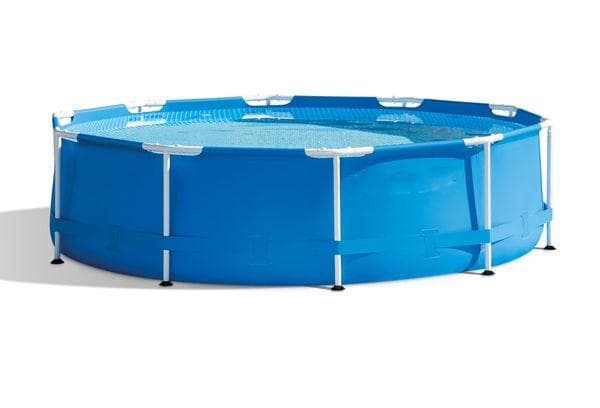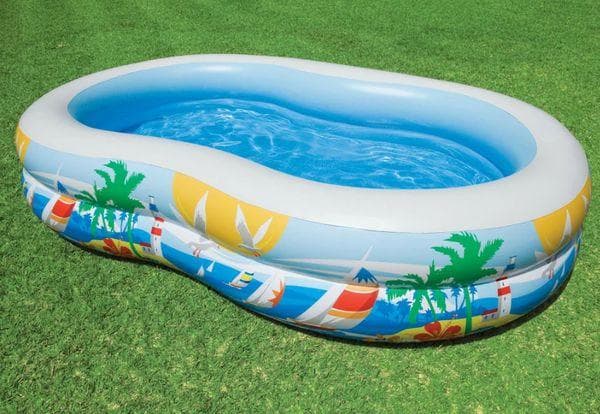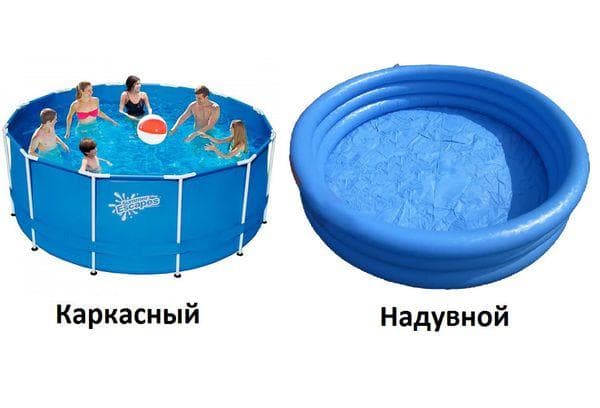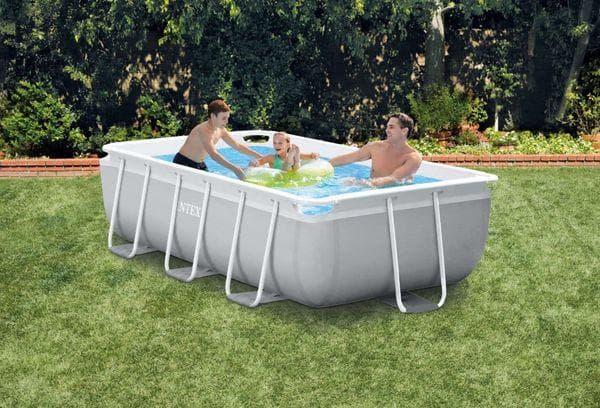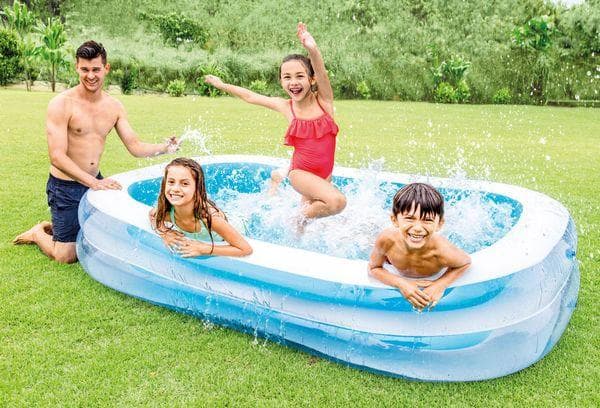Frame or inflatable pool: which is better, more profitable and more reliable. How not to go wrong with your purchase
Content:
With the onset of the summer season, summer residents and owners of private houses are increasingly thinking about installing a swimming pool in the local area. In the process of choosing the right option, homeowners often wonder: which pool is better: frame or inflatable? It is quite difficult to answer this unequivocally, so before making a purchasing decision it is worth comparing the technical characteristics, as well as the requirements that these designs make for the environment.
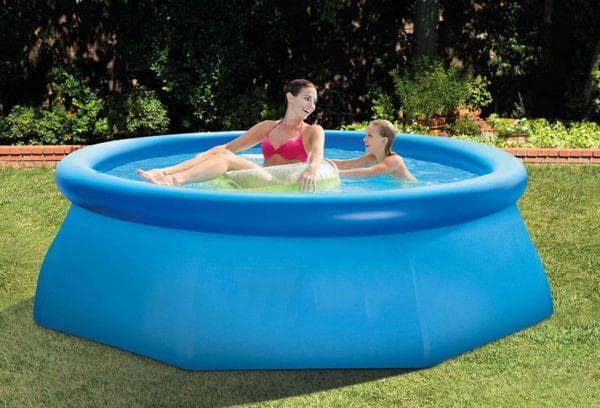
Things to consider before purchasing
Regardless of the type of pool, there are a number of factors to consider before purchasing, including:
- age and size of the main users of the pool;
- frequency of use;
- the number of people simultaneously using the structure;
- the ability to connect additional filtering devices and systems;
- installation area;
- planned budget.
By answering all these questions, you can understand what type of structure will be most suitable for installation in a home or garden area.
What is a frame pool
A frame pool is one of the best budget alternatives to a stationary option.As the name implies, it consists of a frame, fittings and reinforced film. The latter forms a bowl, which is mounted on a plastic or steel frame and secured with special fittings.
The reinforced film is made of three-layer polyvinyl chloride, the frame is made of durable plastic, steel pipes or reinforced aluminum profile. When steel parts are used in construction, they must undergo anti-corrosion treatment.
The following types of frame pools are distinguished:
- Monolithic or stationary. They are resistant to low temperatures and are designed for permanent installation in one place.
- Rod. The frame is a frame with horizontally and vertically directed rods that form stiffeners. A film bowl is installed inside the structure.
- Sectional. The frame design consists of plates made of durable plastic or steel (galvanized).
Also, frames can be divided into lightweight and reinforced. They differ in weight, structural strength and, accordingly, service life. Reinforced varieties can be left for the winter, while lightweight ones are dismantled and stored assembled until the onset of the warm season.
What is an inflatable pool
The design of the inflatable pool is a bowl made of reinforced PVC film, decorated in the upper part with an inflatable ring. The structure takes on the necessary stability when it is filled with air. On the market you can find models with one or several bead rings, which, as a rule, are placed one above the other.Reinforced film often has a ribbed surface to prevent slipping.
Inflatable pools are distinguished:
- by type of material (PVC film, polypropylene fabric);
- in shape (most often round or oval, less often rectangular);
- by color (classic - blue or children's multi-colored);
- in size (children up to 40 cm deep and adults up to 1.2-1.5 m).
Inflatable varieties are also divided into several groups according to their purpose:
- children's (small size, shallow bowl, bright colors);
- children's with slides;
- adults (largest volume and size);
- family (for all ages);
- with a jacuzzi (equipped with compressors and hydromassage systems).
The most stable are round-shaped inflatable pools, which evenly distribute the load around the perimeter.
What is the difference?
Both types of pools differ not only in the main technical parameters, but also in the installation features.
Installation of both types begins with site preparation. The optimal place will be a flat surface, without changes in height, stones and debris.
When installing an inflatable pool:
- A tarpaulin is spread around the perimeter (this will additionally protect the bottom of the structure from damage).
- A place for drainage is organized.
- The reservoir is inflated in accordance with the attached instructions.
Installation of a frame system is a more complex process:
- A frame of horizontal tubes is installed on the selected site.
- Then the vertical bars are secured.
- Everything is fixed using special fasteners and tested for strength.
- A bowl made of reinforced film is installed.
- Water drainage is organized.
- A pump for filtration is connected.
In terms of ease of installation, inflatable varieties win, but in terms of strength and reliability, frames are clearly ahead.
For convenience, all the main characteristics can be presented in the form of a comparative table:
| Inflatable | Frame |
| Budget | More expensive (at least 2-3 times more expensive than inflatable ones) |
| Easy to install | More complex installation |
| Low strength and reliability | Withstands heavy loads without deformation |
| Sensitive to UV radiation, mechanical damage, requires regular pumping | High strength characteristics, including frost resistance |
| Seasonality (can only be used in the warm season) | Stationary models are available that do not require dismantling for the winter |
| Easy to fold and transport | Easy dismantling, possibility of transportation (when folded, they take up more space than inflatable ones) |
| Need for regular manual cleaning | Possibility of connecting a filtration system, eliminating the need for cleaning |
| Depth and size restrictions | No restrictions |
| Mostly round and oval | Variety of shapes |
| Temporary use only | Continuous use possible |
Below we will take a closer look at the advantages and disadvantages of the varieties.
Pros and cons of a frame pool
Frame pools have many advantages. Among them are especially distinguished:
- Practicality. Can be installed on any base.
- Variety of shapes. Thanks to this, frames can fit into almost any landscape design.
- Rich assortment. We are talking not only about the shapes, but also about the sizes of the pools.
- No need for a pump.
- Long service life. More wear-resistant materials compared to inflatable construction.
- Easy to install.You can assemble the frame without resorting to the help of specialists.
- Frost resistance. Resistance to low temperatures allows some models not to be dismantled before the autumn-winter season.
- Possibility of going deep into the ground. Due to the rigidity of the structure, the frame pool can be deepened into the soil by almost a third.
- Filtration. Frames are equipped with a filtration system, which allows you to get clean water and reduce the number of pool cleanings.
Structures of this type can be moved freely. The kit may also include additional equipment (waterfalls, lighting).
Advice! If the film is slightly damaged, you can repair it yourself and this will not affect the performance characteristics of the frame.
As for the disadvantages, the following should be mentioned:
- the need for dismantling if the model is not all-season;
- low strength of the sides (it is not recommended to lean or push off on them);
- higher cost compared to inflatable ones.
And yet, the advantages of frames are an order of magnitude greater than the disadvantages.
Pros and cons of an inflatable pool
The second most popular pools after frame ones are inflatable pools.
They are chosen for the following reasons:
- Budget cost. The price for inflatable structures is 2-3 times lower.
- Easy to install. All you need is a pump and a flat surface.
- Easy to care for. The products are easy to install and dismantle, wash and store.
- Safety. It is impossible to get injured on the soft inflatable sides.
- Large selection of models. The market offers adult and children's pools of all colors and sizes.
Now about the disadvantages:
- Inability to connect the filtration system. The water will have to be changed regularly and the pool walls cleaned.
- Inconvenient drain.This point needs to be considered before the pool installation process.
- Long process of filling with water.
- Stagnation phenomena. Infrequent changes of water can lead to the formation of “green” and an unpleasant odor.
- Low level of strength (compared to frame ones). Accordingly, a shorter service life (no more than 2-3 years).
- Limiting depth, size and shape.
- Negative effects of UV radiation. Strength and elasticity are lost.
- Seasonality. Inflatable pools do not tolerate temperature changes.
Despite the fact that cost is, of course, an important factor, in terms of technical characteristics, inflatable structures are in many ways inferior to frame structures.
What is better to choose
To choose the best option, you must first decide on its purpose and main users.
For families traveling with children, a compact inflatable pool is ideal. Firstly, it is installed in 20-25 minutes, and secondly, the water in it warms up quickly. Thirdly, it can be easily dismantled, folded and does not take up much space in your luggage. An inflatable pool is also suitable for a summer cottage, provided that the owners do not go there very often.
If a country or country house is the main place of residence in the summer, then it is worth thinking about a frame structure. No need to be scared of the price. A frame pool will last several times longer than its inflatable counterpart. Its big advantage is the possibility of “wintering”, that is, at the end of the swimming season, some models do not need to be dismantled.
However, you should immediately tune in to the service, which includes installing a filtration system. If you use the pool frequently, it is definitely necessary. Filters will allow you to clean the bowl less often, the water in it will not bloom and “delight” with odors. In addition, frame pools are an order of magnitude deeper and more voluminous than inflatable ones, so they are better suited for adults.
If only small children use the pool, choose an inflatable option. It is characterized by less depth and risk of injury. Soft sides will reduce the risk of bruises and will allow you to hold onto them and push off. Inflated structures made of vinyl or rubber are the safest for children.
For those who permanently live in the house and do not have the funds to build a permanent pool, it is worth paying attention to frame types. Firstly, you can install it once and not worry about it again (if we are talking about all-season models). Secondly, frame structures will cost much less than building stationary ones. Moreover, modern models, in addition to the innovative filtration system, have many additional “goodies” in the form of slides, hydromassage systems, lighting, water ozonizers and heaters.
Customer Reviews
Most buyers of frame pools, who left their reviews on manufacturers’ websites and specialized forms, note the aesthetics of the design, versatility (suitable for the whole family), strength and durability. Also, many are attracted by winter hardiness and the absence of the need for dismantling for the winter.
As for filters, all large and well-known manufacturers come with them included, so the client does not have to select additional components on his own. Today there are many models on the market that differ not only in size, but also in price. So, if you wish, you can find both a premium pool and a completely budget option.
Inflatable pools are most often purchased for children.Judging by customer reviews, they are attracted by affordable prices and a large selection of colors and sizes. Small models can even be taken on the road. However, everyone unanimously admits that this is a short-term option that will last no more than 2-3 seasons.
